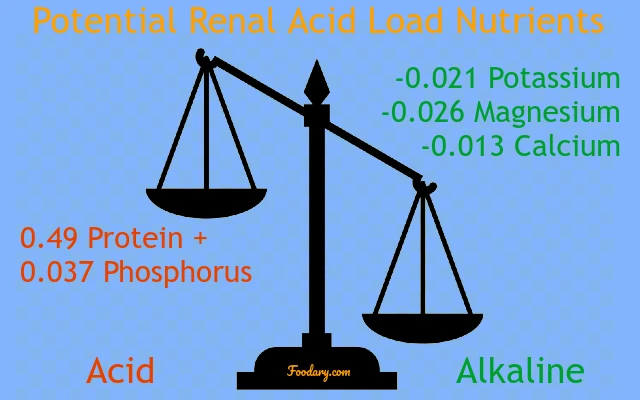
Potential Renal Acid Load (PRAL) Nutrients Defined
Potential Renal Acid Load Nutrients are those substances in food and drink that are used in the Potential Renal Acid Load (PRAL) calculation. The PRAL calculation produces a positive or negative number that can be called PRAL number, value, score, or index. There’s no fixed name for this number as these terms are often interchanged.
The PRAL score is the best indicator of how we can improve an alkaline diet. Though PRAL calculations give absolute numbers, in practice, they should only be used as a general guide. Seasonal variations, different varieties, and cooking methods will all affect the PRAL values. Despite this variation, the numbers are useful in making better food choices. Ultimately, the proof of your alkaline diet comes when you test the pH of urine. The alkaline food lists will help point you in the direction of foods with lower acid load if you need to raise the pH of your urine. There is more information on Potential Renal Acid Load Calculation.
The key to alkaline diets is that 20-30% of foods should be acidic, with the rest being alkaline or neutral. Overall, your PRAL total should be alkaline. There is no general target for Potential Renal Acid Load. Though your doctor might set a PRAL target or a urine pH target in some circumstances.
In general terms, therefore, if we need to increase urine pH, we should exchange some foods for ones with a lower PRAL values. In a varied diet, this should ensure an adequate range of all the nutrients that we need.
Ultimately, the role of Foodary food lists is to prepare the way for a comprehensive database that provides all the nutritional data you need for a healthy diet. It helps to understand the role of different nutrients. This is even more important where illness occurs because different nutrients have different effects in fighting ill health.
Potential Renal Acid Load is fundamental to Foodary healthy eating advice. Therefore, I am going to start detailed nutrient lists with those nutrients that form the Potential Renal Acid Load calculation. I will give a very brief overview of the nutrient here. I will introduce more information when I publish each nutrient list. Later, I will add more detail as I investigate specific illnesses related to excesses or shortages of that nutrient.
Potential Renal Acid Load Nutrients
For all these nutrients, the Daily Values are the recommended total daily intake for a 2500 calorie diet. If you have different energy requirements, you should adjust the values accordingly. Similarly, if your medical advisers have suggested a different intake, then you should use that number, instead of the averages used in current Foodary lists.
Acidic Potential Renal Acid Load Nutrients
The acidic nutrients in the Potential Renal Acid Load calculation are protein and phosphorus.
Proteins are essential for growing and repairing body tissue. Protein food sources include meat, fish, eggs, milk, beans and other legumes. The Daily Value for protein is 50 grams.
Phosphorus is required for bones and teeth, and it also works with proteins for cell regrowth. It is necessary for many functions within the body. Phosphorus food sources include meat and milk. Though whole grains contain phosphorus, it is in a form not usable by humans. The Daily Value for phosphorus is 1,000 mg.
Alkaline Potential Renal Acid Load Nutrients
The alkaline nutrients in the Potential Renal Acid Load calculation are potassium, magnesium, and calcium.
Potassium is essential for helping proteins and carbohydrates maintain normal growth and build muscle. It is also essential for controlling vital heart and blood functions. It is available from most foods. Potassium food sources include meat, fish, milk, nuts, and many fruits and vegetables. The Daily Value for potassium is 3,500 mg.
Magnesium is essential for many vital processes throughout the body. Magnesium food sources include dark green, leafy vegetables, and many other foods. The Daily Value for magnesium is 400 mg.
- Calcium
- Calcium is essential for bones and teeth, and it is also vital for many body functions. Calcium food sources are mainly dairy products, but many other foods can provide it. The Daily Value for calcium is 1,000 mg.

Potential Renal Acid Load Nutrients Lists
The Potential Renal Acid Load nutrients lists show the top foods for each of the above nutrients. Each food or drink uses the description from the USDA nutrition database. To allow comparison between different foods, they are listed for a serving that provides 100 calories. The weight of food that provides 100 calories is shown in grams. For some zero or low-calorie items (marked at the end of the description *), I calculate the values for 100 grams. The PRAL value is included, as described in Potential Renal Acid Load Calculation.
If you have any questions, opinions, or experiences to share about PRAL nutrients, please use the feedback form below.
Leave PRAL Nutrients to read Foodary Home Page.
PRAL Nutrients Related Topics
Please remember: to find more related pages that are relevant to you, use the search box near the top of every page.
Common Terms: define, menu, Most Helpful Foodary Articles, nutrient
